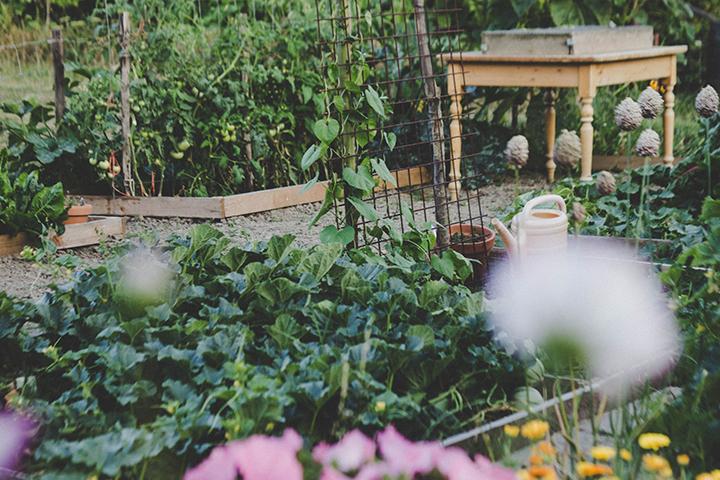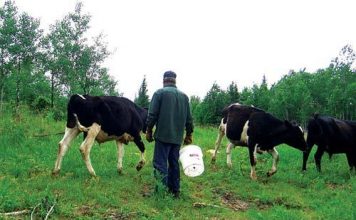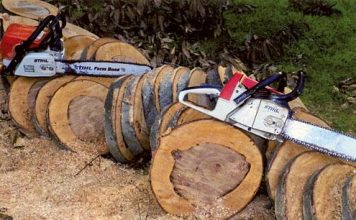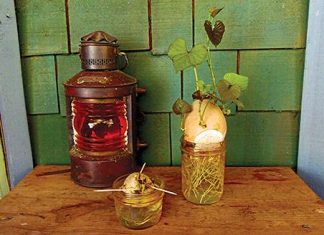 |
|
| Issue #62 |
Many of us have a garden and enjoy fresh vegetables during the summer and fall. Maybe we even have a few chickens for eggs and meat. But many of us may want to extend our homesteading to what I call “hard-core” homesteading. This is serious homesteading, aimed at being able to provide your family with nearly all of its basic needs.
Luckily, most of us with a piece of out-of-the-way land can become nearly “store-bought-free,” raising much of what we need in nearly the same way as did our ancestors.
There is a vast difference between this type of survival homesteading and stars-in-the-eyes, back-to-nature, recreational homesteading to relieve stress and provide enjoyment. The difference is not so much in how-to, but in discipline and learning.
The survival garden
It has been said that one can raise enough food for a family of four in a 50- by 50-foot space. While such an area can provide a goodly amount of food, there is no way a family could survive, year-round, off such a small patch. In reality, all that this is is a “house garden” for providing fresh produce such as greens, broccoli, cabbage, peppers, herbs, etc.
When one needs a garden to put up food, not only for the winter but
possibly for a year or two, we’re talking about at least an acre of
intense cropping.

A few rows of beans will produce quarts and quarts. |
This includes a patch of wheat for grinding into cereal and flour; flour corn for hominy and corn meal; sweet corn for eating, canning, and dehydrating; and rows of dry beans as well as fresh beans (yellow wax, green, pole, etc.) for putting up. Here we stumble on the weak link in most folks’ gardens. They say “We only use a few pounds of corn meal or dry beans a year,” and they feel confident they can get by with just a few packages of such items, bought at the grocers.
But having lived in a wild corner of Montana, well above the “grocery line” (because of road accessibility), I can tell you that you will use many more pounds of these staples when you cannot eat from the store shelves.
And if there are no store shelves to choose from, we will all need to take care of our own needs at home. Remember, it takes more than one year to get a garden into full production. You can’t just plow up a plot and expect to survive off of it, especially if you lack experience.
You can’t grow everything, everywhere. Look at your local production capabilities. Here in New Mexico I can grow anything. In the high country of Montana, nearly everything was a challenge even though I’ve gardened all my life. But we could survive from my Montana garden with potatoes, wheat, and beans along with a number of cold-loving crops we grew. What you need to do is put your energy into growing what will make a crop in your location.
But don’t be afraid to experiment. Everywhere I’ve gardened I’ve grown crops that locals said “wouldn’t grow.”
To better use space, consider inter-planting as much as possible. Grow cornfield beans among the flour corn, radishes in the same row as carrots, peppers between rows of tomatoes (which act as windbreaks), pumpkins and squash next to a corn field where they can run into the corn after cultivation has stopped. (Don’t do this with sweet corn or you will have a devil of a time picking the corn stumbling among rampant squash vines.) Inter-planting will do much to save garden space, a large consideration in survival gardening, especially when you must cultivate and till by hand.
Crops for a survival garden
Everyone who gardens grows some things just because they enjoy the taste. This is great, and we all do it. But in hard-core homesteading, we must consider our basic needs, as well.
We need to grow enough grain and corn for ourselves and livestock. This can be done by hand, in a relatively small plot, provided that our poultry and livestock needs are small. If you need more grain, say for cattle or horses, consider small scale farming with horses. This is a sustainable way of living as horses are easy to work, versatile, and provide manure for the fields. They also require no fuel to run. One team of moderate-sized horses can do as much work as a small tractor and cost little to maintain.
As little as an acre of ground can supply modest grain needs for a family homestead. Include a bit of rye, oats, and barley for variation. (There is a naked-seeded oat that is great for homesteaders, as at home one has a difficult task in hulling oats for oatmeal.)
Besides small grains, include your rows of flour corn for corn meal and hominy, being sure to include enough for livestock feeding.
Most folks have to double or even triple the amount of usual garden produce to allow for putting up as much each year as possible. Be sure to allow for lots of tomatoes for tomato sauces, and enough root crops, such as turnips, potatoes and carrots. (You’ll eat a lot more “homegrown” when you can’t run to the store for “quick” meals.)
With all survival garden vegetables, a family should buy only open pollinated varieties. This will enable folks to save seeds from year to year, which is not recommended with hybrids. Hybrid seed, while usually fertile, can not be depended upon to reproduce truly. And, contrary to popular belief, most of those old open pollinated varieties are good tasting and hardy.
Perennial for the survival garden
Along with the vegetables, a hard-core homesteader should establish a good variety of perennial edibles. These include asparagus, Jerusalem artichokes, horseradish, garlic, perennial onions, and herbs for both culinary and medicinal use.

A survival homestead needs |
Remember to encourage native perennial edibles which do well in your area. These may include prickly pear cactus (the fruits and pads are eaten as a vegetable), wild rice, wild greens, cattails, mushrooms, etc. In a survival situation, one truly appreciates variety in the diet.
The perennials have the advantage of having to be planted only once and usually expand on their own with little human help. And, like the annuals, which must be planted each year, a family can gather and put up many jars full of winter eating. I can wild and domestic asparagus, wild mushrooms, wild greens, cactus pads (known as nopalitos in the southwest), and dry many other wild and domestic perennials.
Small fruits are nearly essential
Nearly everyone has room to plant a good selection of small fruits. These include strawberries, raspberries, blackberries, rhubarb, blueberries, and so forth. Luckily, once a patch of each has been established, one can readily take divisions or replant sprouts to greatly increase their food-producing capabilities.
As with the vegetable garden, one should grow as great a variety of small fruits as possible, and enough of each to put up significant jam, preserves, and canned and dried fruit. In hard times, a good loaf of hot whole wheat bread spread thickly with homemade strawberry jam, or a steaming blueberry pie, makes the term “survival” a joke. We call it living good.
You quickly discover that small fruits are a wonderful treat that can be easily turned into strawberry shortcake, blueberry pancakes, rhubarb tarts, blackberry cobbler, etc. In hard times, you don’t eat many candy bars; instead you substitute healthier fruit snacks and desserts.
Even picky eaters greatly enjoy dried fruits and fruit leathers which are easy to make at home.
Every homestead should include a small orchard
Even the smallest homestead has room for fruit trees. With the variety of tree sizes and shapes, you can choose full-sized trees which are tremendous producers, but take room and several years to begin bearing fruit. Semi-dwarf trees, which usually require only a 10- by 10-foot spacing, produce full sized fruit in moderate amounts and only take a couple of years to bear. Dwarf and “pole” trees, which produce full sized fruit in small amounts, can be raised on a patio in a portable tub.
A hard-core homesteader can get by with two each of several varieties to provide variety and cross-pollination. I’d suggest apple, pear, pie and sweet cherry, apricot, and plum for most gardeners. Of course, if you can grow citrus in your zone, go for it. We live in zone 5 and have two Brown Turkey Figs in a protected corner of our east flower bedprotected by the house from the killer winter north winds.

Small fruits go a long way to alleviate hard times. |
Now a lot of folks say they’d need acres and acres to reach this level of self-reliance in the food department. Not so. My grandmother did it on two city lots in Detroit. Instead of normal landscaping, nearly everything she grew produced edible fruit: peach, grapes, brambles, quince, asparagus, apple, crab apple, strawberry, etc.) Having gone through the Depression as a widow with two young boys to raise, Grandma knew how to fend off hard times.
But what about meat?
Like produce and fruit, a family can grow all of their meat requirements, right at home. Now few people actually like to kill to eat, but when it comes down to eating or not eating meat, most of us can find a way around our revulsions. After all, someone had to kill that steer that went into your Big Mac. It gets ridiculous when visitors won’t eat a home-butchered beef roast but will buy a tainted, chemical-laden piece of plastic-wrapped roast at the supermarket and eat it with abandon.
Folks on a very small acreage will usually have to limit their meat production to poultry, rabbits, and perhaps a little goat meat. A small flock of chickens for egg and meat production, with a couple of hutches of rabbits and the castrated male offspring of the family dairy goats will do much to help out at the dinner table. Of course, a family with these reduced production capabilities will not eat meat every day, but it will be able to enjoy regular meals with meat as a feature.
The benefit of having only a small poultry flock, a few hutches of rabbits, and very few goats is that the feed requirements and labor requirements are also minimal. In such cases, a family can easily hand-raise and harvest all feeds necessary to maintain their meat and egg supply.
Small-holders can help supplement their meat needs by hunting and fishing. But remember, if times are hard nationwide, subsistence hunting will become very difficult in most areas, as it did during homestead days and during the Depression. The game quickly disappears with overhunting. Fishing holds up much better, so it benefits a family if they hone fishing skills before they are truly needed. (Besides, it’s enjoyable family “work,” as well.) For lucky backwoods dwellers who live near the seacoast or a salmon stream, fishing can well be the major source of family meat.
Folks with more acreage are in better shape to truly be meat self-reliant. Using horsepower to till moderate amounts of land, a family can raise enough small grain, field corn, and forage (hay and pasture) to maintain not only the horses but a couple of dairy cows or several dairy goats. Let me stop right here and address you folks who are saying, “Goats! No way am I going to raise those stinking tin can eaters!”.
Goats do not eat tin cans, nor do they run around butting people, any more than do cattle. Goats are exceptionally clean, picky eaters, refusing to take a bite of the apple you just took a bite out of, and they’ll dehydrate before they will drink from a bucket containing even one berry of manure. Only bucks in rut have any odor. While in rut they will spray their neck, belly, and chin with urine as an attractant to does in heat. So do elk and deer. The normal scent glands on a buck’s head, which produce scent during rut, can be removed by surgery when the buck is an adult or during disbudding, leaving a scent-free male totally capable of breeding. Does never have an objectionable odor, and with neat droppings the pen is quite clean and odor-free with even minimal daily maintainance.
We’ve had both dairy goats and cattle, and we know the benefits and drawbacks of each. Both produce milk which is equally good-tasting. A goat often produces multiple offspring while a cow produces one calf a year.
Cattle are easier to fence in, but goats will do great in a pasture grown over to willows and brush as they are by nature browsers like deer. And, like deer, they can hop a four-foot field fence to enter your young orchard and strip the tender trees of their bark and twigs. Cows produce beef; goats
produce chevron. Both are good,
but different.
Chevron comes in carcass weights from between 20 and 100 pounds of dressed weight, depending on age. They are easier to cut up and handle, but their small carcass lasts a much shorter period of time than a 600-pound Angus carcass.
Remember that worldwide there are thousands more goats used for meat and dairy production than there are cattle. There are reasons, and economy is at the top followed by the quickness of meat consumption in areas without refrigeration. A 600-pound cattle carcass is likely to spoil before it’s completely consumed.

Chickens provide both meat and eggs for a survival homestead. |
Pigs are another cog in the serious homesteader’s wheel of self-reliance. Not only can a few pigs easily be raised for butcheringbeing fed from home-produced feed, kitchen and dairy waste (skim milk is an excellent food), along with weeds, pasture, and hog-foraged feedbut they provide excellent meat with a carcass that is quite easily handled by the family. The bonus of hogs is that they produce lard, the only homegrown cooking fat easily obtainable.
Yes, I know about high cholesterol, but let me tell you that when you are working hard everyday to put food and other necessities on the table, your cholesterol will balance easier than your finances.
Homegrown dairy products
Okay, so far you have a good vegetable plot, small fruits, small grains, and an orchard and meat/egg supply started. It’s time to think about dairy products, particularly milk and cheese. After that stored dry milk is gone, your family will want something to replace it. And what is more natural than learning to run a tiny kitchen dairy and cheese plant? All dairy products are quite easy to produce
at home, and as with almost everything else, it’s much better when
homemade.
I’ve made cottage cheese, cream cheese, mozzarella, colby, cheddar cheese, sour cream, cheese spreads, balls, logs and sandwich loaves, ice cream, ice milk, sherbet, and more regularly at home, both from cow and goat milk. Butter and whipped cream are easier to do from cow milk, as the cream quickly separates out, floating to the top. Goat milk is naturally homogenized and it takes more “doing” to access the cream. Both animals’ milk produces good-tasting dairy products.
|
A good milking doe goat will produce about 3 quarts each milking, on average, where an average milk cow will produce much moreabout three gallons. So your choice will depend on your facilities, labor and needs. Remember that all “extra” milk can be used to produce dairy products such as butter (which can also be used as a cooking fat) and cheese; dairy by-products can be fed to chickens and hogs. Extra milk can be used to bottle feed young calves or kid goats. On a survival homestead, there is no waste!
When planning on establishing a home kitchen dairy, be sure to stock up on such things as rennet tablets, which make forming cheese curd much easier and more reliable, cheese cultures (as you need for some “fancier” cheeses), cheese cloth and a cheese press or the materials to make one. These materials can be as simple as a #10 can or a 4-inch piece of PVC pipe and wood.
Okay, now we have your family ready with a vegetable garden, small fruits, grains, orchard, meat/eggs, and dairy production. Pretty nifty, right? You bet. For now you can also make soap from used cooking fats, which you can save in a can after each use. Soap making is easy and glitch free, requiring only strained, clean used fat and lye (which can be produced by seeping water down through wood ashes). This soap is great and can be used to wash clothes, babies, and hair.
Add a hive or two of bees, and your sugar requirements are easily met. Then too, the bees will pollinate your entire garden, grain patch and orchard, ensuring bountiful harvests. Bees are easily established and easy to work with. I’ve only been stung twice working with domestic bees, and probably a few dozen times by “wild” bees.
Survival homesteading is addicting. Once you get started, your mind works constantly at ways you can do more to be less reliant on the system. Now I say “can do” as few homesteaders actually practice every bit of their knowledge. I can raise and shear sheep, spinning wool into yarn to make clothes. And I can tan hides from which to fashion clothes and footwear. But I choose to use my time in other ways, which are more productive to the family at present. But the knowledge is there, should our needs change.
Survival homesteading is rewarding, financially and spiritually, as a basic instinct in human beings is to provide for their own and their family’s needs. Never become overwhelmed by feeling that you must do everything at once. It is better to proceed in steady forward steps, rather than to run forward, fall and lose heart. One vital tip: start small and work your way up as your ability and knowledge increases. Your survival homestead depends on it.
















We have had to rely on cornmeal due to climate. There are good heirloom varieities and also a special breeding program out of Montana (Painted Mountain). Several good short season varieities. One year, I grew buckwheat, but it was very labor intensive… a lovely plant, though.
In northern climates, an absolute minimum of a self-pollinating or grafted apple tree and an Italian Prune as they can be canned, dried, frozen and are versatile in recipes. Consider blueberries, but invest in the largest bushes you can find and afford as they grow slowly. Grapes produce bumper crops.
Rhubarb (needs sugar) and Jerusalem Artichokes can be “Armageddon” perennial plants. Find a place to let garlic go wild so you have a perpetual supply of garlic scapes as a vegetable every spring.
Our mainstays for winter food supply and cold storage are carrots, squash, cabbage (kraut). (We cannot overwinter carrots in the ground in our climate. Potatoes struggle, too.) I can lots of green beans.
Do not forget to forage from the wild–lots of mushrooms and berries. Check parks and govt lands (unsprayed) and also around old homesteads. Many heirloom orchards (and nut trees) remain. Also, find places to glean–esp. organic orchards. Ask around. You can never have too many apples and may be able to rent a cider press for a modest cost for an afternoon.
Plan ahead for freezers, freezer containers and canning lids. Buy off season or look for free when people are moving. Network with realtors, etc.
Good article Jackie. Having also participated in off grid homesteading for years I appreciate the truth in what you have written. I would like to opine on a couple of points and add to your pretty comprehensive list of needed skills and requirements. First of all I would say that having a combination of hybrid seeds (which are sometimes easier to purchase) and heirloom seeds can be a good thing. We live at approximately 7000 ft. elevation and there are good years to plant and there are hard years to plant. It makes little sense to waste your heirloom seeds during years that are obviously colder than usual or like this year which which not only had a cold late spring but an incredibly dry hot summer. We are in severe drought. Spend your hybrid seeds on such a year and save those heirloom seeds for years that you can have an adequate or even abundant crop and can do more than hopefully just make your seed back. Look at late blooming crops such as black raspberries or blackberries. Quite often our apricots and peaches and apples are frozen in bloom but we can still gather a crop of berries. Growing hulless barley and hulless oats is a great idea but can be a challenge. Acquiring the seed is a challenge in itself. Over the last 100 years small farmers and homesteaders have lost over 90% of the seeds our ancestors planted and were able to utilize with simple machinery or by hand. They no longer exist. There are a few of us that are trying to keep some varieties alive but I fear the list of participants is short. Barley seed is fairly common but most of it is now two row barley which is high in carbs and needs machinery to be hulled. The high carb varieties are in demand by folks who brew refreshment and sell it. The ancient varieties such as “Arabian Blue Barley” and “Burbank Barley” are six row barley that require no machinery to hull and are high in protein (as high as 14%). They are better suited for baking and are very hard to come by. Hulless oats such as “Spokane” and “Ceasar” and “Laurel” are also not common. Growing these grains can be an education. Barley needs good soil or it will lodge. You need to know your soil before you plant. Planting a hard to come by seed and watching it grow up and lodge can be a little traumatic. Get ahead of the curve. Large animal harvest without refrigeration requires a special set of skills and equipment. Stoneware crocks and a smokehouse are a necessity. In days of yore our Dept. of Agriculture had much information available for small family farms on food preservation. A few of these bulletins and papers can still be found at some land grant universities but I suggest getting hard copy when ever possible. People today take salt for granted. It will take at least 7 lbs. of pure salt to cure 100 lbs. of meat. There are still a couple of places where you can buy stoneware that has no lead in the glaze. They aren’t cheap but it is difficult to cure meat without them. They are also handy for fermentation which is another skill set that is handy to have and which also requires salt. We lived without electricity for over 15 years and there are many other issues that could be addressed such as necessary tools and equipment but I wax loquacious. Again, I think you covered a lot of ground and did a good job. Best to you, Dale
I love reading your magazine, whenever I head to the local bookstore, and whenever visiting grandma’s house. I finally bought my own subscription and can’t wait.
Thank you for all you write and advise. Keep up the good work.
Thank you Jackie for your excellent, practical writing. In 2013 my wife ordered your canning book. We had been married 20 years but only water bath canned because both of our mothers had been afraid to pressure can. With your books we dove into pressure canning. I haven’t gardened in recent years due to work and caring for my wife as her health failed. She passed in March and I have started building the garden again and taking self-relience to a new level for me. Look forward to reading more of your writing since my pastor gave me an old Kindle and hooked up to the church’s wireless (live next door)(easier than the trips to the library).Thanks for everything!